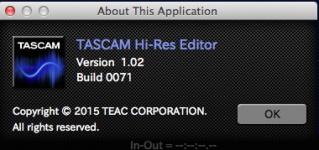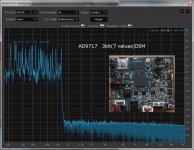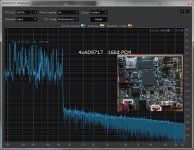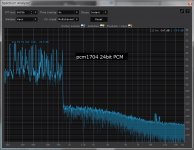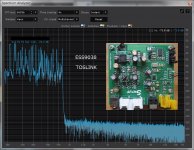Hi again,
I think we might be misunderstanding eachother ... If I am not mistaken the links you provide are related to the 384 kHz fs Amanero board that has been out for some time now. However, Domenico also worked on a 768 kHz fs board at some point in time:
YouTube
This is the one I am referring to ... Is it also the one you are talking about?
Cheers,
Jesper
I think we might be misunderstanding eachother ... If I am not mistaken the links you provide are related to the 384 kHz fs Amanero board that has been out for some time now. However, Domenico also worked on a 768 kHz fs board at some point in time:
YouTube
This is the one I am referring to ... Is it also the one you are talking about?
Cheers,
Jesper
Hi Jesper, yes we misunderstanding each other, you are asking for a new board & I'm refering to a new firmware.
Yes, I thought so - good to have it clarified ;-)
I will ask Dom and let you know.
Thanks. FYI I have asked before but my impression was that Domenico was busy so I didn't get a reply at that time. But I would be very interested in knowing about if/when it comes.
Cheers,
Jesper
So he is saying that the next Amanero will be capable of768 Khz in 2 channels and 384 Khz in 8 channels???Jesper that's Dom answer:
"La scheda è pronta già da un pò il nome iniziale è Ultra M4 ( M4 è la CPU un Cortex Arm M4 ). Appena possibile la metto in produzione, però, è più indicata per registrare può funzionare come 2x2 Input/Output 768Khz oppure un 8x8 384Khz
Dom"
Can't wait for that. I am in need of at least 4 channels for my speaker system, so this comes as a very pleasant information. Any ETA?
So, without being entirely conclusive about this, I see one potentially very attractive D/A solution to be a "single bit/single frequency" conversion system where the signal processing is done outside the DAC itself - and then the DAC "just" handles the creation of this (sufficiently, yet not much) processed signal at one given frequency.
Jesper
Thank you for your feedback.
As to DSM, I'm not sure weather 1bit is the best or not. It depends on your situation because your music file dominates the answer. 90% of my file is classical music, where high SNR is everything. I can hear the difference between 94dB and 108dB. The higher, the better. But when I listen to Jazz, SNR isn't mandatory. The lower "noise floor modulation," the better. 1bit DSM is inherently inferior to 2bit DSM in SNR, though analog FIR with more than 16-taps can compensate for the disadvantage. It also has instability problem when the input is from on to off or from off to on even the frequency is the same. You have a potential possibility of large pop noise. More than 2bit(including 2bit) DSM is free from such problem and has high SNR.
The disadvantage of multi-bit DSM is calibration. If your target is a measurement tool, 5bit or 6bit is the candidate that has excellent THD but requires complicated calibration. 2bit DSM is probably optimum for music playback because calibration requires only one coefficient. THD in classical music matters little as long as I have experienced. The top priority is SNR. So, the best solution for me is 2bit DSM, where high SNR, stable operation, simple calibration, and low "noise floor modulation." But I would say 1bit DSM is the best in some situation and multi-bit(pcm1704) is a little bit old-school for me now. The audio system isn't so simple. That's why it's challenging, though I needed to say good-bye to pcm1704.
Thank you for your feedback.My system is already a single frequency(96kHz/24bit) because if you have a digital crossover inside DAC for multi-system, multiple frequencies require multiple coefficients, e.g., too many coefficients.
My music file is 44k, 48k, and 96k, where the transport with SD memory converts them into 96kHz/24bit. One frequency system is convenient and easy to design.
Off topic, I realize that 16 bit or higher pulse code modulation may not be of interest on this thread. Still, a minor point of information:
For PCM music files, a digital crossover can automatically manage multiple frequencies using only one set of coefficients. It requires filters in the LADSPA format and they must be run within ALSA on Linux. More information here:
LADSPA filters for digital crossovers on the BBB
OK, back to the interesting questions being discussed here...
Zoran, do you by any means have some measurement data of these?
Would be nice to see the signal to noise or distortion products of this circuit, at different levels; could be awesome!
Hi Mterbekke, I found some amateur measurements of the initial circuit. (lap top input, software Electroacoustics Toobox.) I think that the circuit was with Beyer dynamics input transformer, and maybe with Single ended JFET buffer after the xfrm. No any filter (ecept xfrm transfer...)
Attachments
Last edited:
@Felipe: Thank you very much for asking Domenico  - and of course also to him for replying ...
- and of course also to him for replying ...
It looks like an interesting board so I do hope that he will make a more detailed description available - I will be most intrigued to read more about it as a genuine quality recording + more USB card option!
@mterbekke: Hmmm ... in the back of my mind your measurements of HQPlayer combined with a single one bit FF (#2019) have been simmering for some days now. Just to make sure:
The second image is only a 1-bit FF which is then combined with the HQPlayer modulator you mention? Looks impressive in terms of low HF noise ... ... Would you happen to know if the AMSDM7 etc algorithm is optimized for such 1 bit DSM?
... Would you happen to know if the AMSDM7 etc algorithm is optimized for such 1 bit DSM?
@xx3stksm:
Thank you also for your feedback ... Reading it I am thinking that it is fascinating to observe that your knowledge areas likely at least somewhat different from mine: Something like FPGA programming indeed is not my strength - although years ago I really was keen on learning it because I could see the clear advantage of being capable of doing such programming. But, alas, time & mental "surplus" has not allowed for this.
... Reading it I am thinking that it is fascinating to observe that your knowledge areas likely at least somewhat different from mine: Something like FPGA programming indeed is not my strength - although years ago I really was keen on learning it because I could see the clear advantage of being capable of doing such programming. But, alas, time & mental "surplus" has not allowed for this.
Hmmm ... interesting to hear this ... About a year ago I happened to make a "high quality" balanced amplifier - for a recording system - which comparatively was of lower distortion than the single-ended designs I had tried up to this point. And, much to my surprise, since I like the fluidity and seamlessness of single-ended designs (to my ears that is), I suddenly noticed what low(er) distortion may do to the reproduction of music. Much clearer spatiality, more nuanced tonality, generally more stringent and likely correct sound, while still musical and with drive. I actually liked it and preferred it over the single-ended IMHO also very good sounding design.
I have taken a quick glance at the AD9717 and I notice that it is capable of 125 Msps sampling rate ... Can I ask you why you don't take this opportunity to do e.g. 768 kHz/24 bit sampling? I personally believe and seem to observe that - if well-designed - higher sampling rates may allow for more detail and openness - better tonal nuance and overall coherent sound (again to my ears) ...
... Can I ask you why you don't take this opportunity to do e.g. 768 kHz/24 bit sampling? I personally believe and seem to observe that - if well-designed - higher sampling rates may allow for more detail and openness - better tonal nuance and overall coherent sound (again to my ears) ...
Regarding your description of the various DSM bit levels it admittedly is beyond my technical knowledge. Yet I read what you write and as I am indeed also very fond of classical music I take notice of your comments on SNR and THD. As it is I currently use a much modified DDDAC (PCM1794) which I really like (I find it a.o.t. to be very musical) and also because I prefer a current output as it allows a simple implementation of utterly low-THD amplifier circuits (the I/V is in the amplifier) without any GFB. It is reasonably low THD (2H at ~ -107 dB; single-ended output) but its basic noise levels (as your measurements indicate) seem to shift ...
Also, the PCM1704 has been on my "design table" for YEARS! (I have two of them) but as my thinking about DACs has evolved, and realizing the (apparent?) disadvantages of a low impedance & low level current output, it has never really materialized. And now I think I will let it be permanently ...
I have then considered making a discrete R2R DAC (balanced; high current output) but considering the amount of quality resistors needed and the potential issues high-frequency-wise between the switches I have also let this be ...
So I am curious about your AD9717 design - again reading the datasheet it looks as if it may be capable of 2*4 mA output - is that also your reading? And may I ask if this is what you do? BTW & FYI, I will be off on some days' vacation so I may not reply to any posts from you (should you be so inclined) - or others for that matter - in the next ~ week's time.
Cheers,
Jesper
It looks like an interesting board so I do hope that he will make a more detailed description available - I will be most intrigued to read more about it as a genuine quality recording + more USB card option!
@mterbekke: Hmmm ... in the back of my mind your measurements of HQPlayer combined with a single one bit FF (#2019) have been simmering for some days now. Just to make sure:
The first image is taken with the DSD7 +256FS modulator,
the second with the AMSDM7 512+FS type, both Poly-sinc-2s.
The second image is only a 1-bit FF which is then combined with the HQPlayer modulator you mention? Looks impressive in terms of low HF noise ...
@xx3stksm:
Thank you also for your feedback
90% of my file is classical music, where high SNR is everything.
Hmmm ... interesting to hear this ... About a year ago I happened to make a "high quality" balanced amplifier - for a recording system - which comparatively was of lower distortion than the single-ended designs I had tried up to this point. And, much to my surprise, since I like the fluidity and seamlessness of single-ended designs (to my ears that is), I suddenly noticed what low(er) distortion may do to the reproduction of music. Much clearer spatiality, more nuanced tonality, generally more stringent and likely correct sound, while still musical and with drive. I actually liked it and preferred it over the single-ended IMHO also very good sounding design.
My system is already a single frequency(96kHz/24bit) because if you have a digital crossover inside DAC for multi-system, multiple frequencies require multiple coefficients, e.g., too many coefficients
I have taken a quick glance at the AD9717 and I notice that it is capable of 125 Msps sampling rate
 ... Can I ask you why you don't take this opportunity to do e.g. 768 kHz/24 bit sampling? I personally believe and seem to observe that - if well-designed - higher sampling rates may allow for more detail and openness - better tonal nuance and overall coherent sound (again to my ears) ...
... Can I ask you why you don't take this opportunity to do e.g. 768 kHz/24 bit sampling? I personally believe and seem to observe that - if well-designed - higher sampling rates may allow for more detail and openness - better tonal nuance and overall coherent sound (again to my ears) ... Regarding your description of the various DSM bit levels it admittedly is beyond my technical knowledge. Yet I read what you write and as I am indeed also very fond of classical music I take notice of your comments on SNR and THD. As it is I currently use a much modified DDDAC (PCM1794) which I really like (I find it a.o.t. to be very musical) and also because I prefer a current output as it allows a simple implementation of utterly low-THD amplifier circuits (the I/V is in the amplifier) without any GFB. It is reasonably low THD (2H at ~ -107 dB; single-ended output) but its basic noise levels (as your measurements indicate) seem to shift ...
Also, the PCM1704 has been on my "design table" for YEARS! (I have two of them) but as my thinking about DACs has evolved, and realizing the (apparent?) disadvantages of a low impedance & low level current output, it has never really materialized. And now I think I will let it be permanently ...
I have then considered making a discrete R2R DAC (balanced; high current output) but considering the amount of quality resistors needed and the potential issues high-frequency-wise between the switches I have also let this be ...
So I am curious about your AD9717 design - again reading the datasheet it looks as if it may be capable of 2*4 mA output - is that also your reading? And may I ask if this is what you do? BTW & FYI, I will be off on some days' vacation so I may not reply to any posts from you (should you be so inclined) - or others for that matter - in the next ~ week's time.
Cheers,
Jesper
@mterbekke: Hmmm ... in the back of my mind your measurements of HQPlayer combined with a single one bit FF (#2019) have been simmering for some days now. Just to make sure:
The second image is only a 1-bit FF which is then combined with the HQPlayer modulator you mention? Looks impressive in terms of low HF noise ...... Would you happen to know if the AMSDM7 etc algorithm is optimized for such 1 bit DSM?
Cheers,
Jesper
Jesper, both measurements only differ in the way HQPlayer upsamples the data, so both signals are made by the same 1 bit flip flop. It's not hard to see the base level around 120 dB lower than the test signal with cmos, it's all about using good clocks and a good layout etc. The main point indeed was trying to get lower distortion at the -40 to -60 dB range, it's more important than the 0dB (or -80dB) signal. Dynamic range tends to go down a few decibels above dsd256, but other hardware, or some more tweaking can fix that ;-)
Did you mean this by "low HF noise"?
Hi Mterbekke, I found some amateur measurements of the initial circuit. (lap top input, software Electroacoustics Toobox.) I think that the circuit was with Beyer dynamics input transformer, and maybe with Single ended JFET buffer after the xfrm. No any filter (ecept xfrm transfer...)
Looking nice Zoran, thanks for sharing. I don't know what to make of the second pic though, any idea why the measurement signal isn't there yet should be there?
Jesper, the modulators have been discussed here before but I don't have any knowledge about them in any way that would make my opinion or insight valid. As an example: the dsd5 versions are meant to be used for simpler dac structures(as in for these No-dac dacs), and the dsd7 versions for more advanced types.
As you can see this doesn't hold true per se and in my experience the 7 versions give better results. The AMSDM7 is another beast alltogether.
In other words: don't mind the descriptions or manual of the software regarding that specific part. Btw the manual comes installed when you try the software.
As you can see this doesn't hold true per se and in my experience the 7 versions give better results. The AMSDM7 is another beast alltogether.
In other words: don't mind the descriptions or manual of the software regarding that specific part. Btw the manual comes installed when you try the software.
I have taken a quick glance at the AD9717 and I notice that it is capable of 125 Msps sampling rate... Can I ask you why you don't take this opportunity to do e.g. 768 kHz/24 bit sampling?
High sampling rate like 768kHz/24bit isn't the dominating factor to have excellent quality, IMHO. One reason is that my files are ripped from vinyl which doesn't mean wide range. I usually use 96kHz/24bit. SPs and monaural LPs are decimated into 48kHz/24bit. Stereo LPs are 96kHz/24bit. I don't have files deserves 768kHz, though my SD card reader can work at 192kHz/24bit. But even in PCM, OSR is the same as DSM(x64,x128,x256, and x512) because of the high sampling frequency of AD9717.
AD has many communication DACs for W-CDMA. AD9717 is one of them. The most powerful one(AD9747) is 16bit@250MHz and 32mA with RZ function. I, of course, tried it and failed. Besides AD971X, communication DAC is less SNR in the audio band. Their playground is RF, not the audio band. That's why AD971X has the less current drive(up to 4mA). Low current supply brings you high SNR in the audio band.
It's surprising to change my favorite chip since I have been with pcm1704 for 20 years. But now is the time to design 1bitDSM. IMHO, 1bitDSM lives in another dimension, where no DAC chip exists; in other words, no DAC chip related limitation exists. DAC chip(including AD9717) is inferior to OP-amp in SNR by almost 20dB, i.e., noise power of DAC is 3uVpp,OP-amp is 0.3uVpp. If your DAC consists of discrete transistors, you are free from the inherent limitation. It's worth designing, especially for a DIYer because monolithic DAC is impossible but discrete one(FPGA and transistors) is possible and very promising to have extraordinary high SNR for classical music.
Here are some pics about noise floor modulation. 1st pic(AD9717 in 3bitDSM) is the best one so far. The input is band-limited music file(Toccata and Fuga in D minor). If your DAC is ideal, more than 800Hz must be the noise floor with no fluctuation. 3bitDSM is better than 2bitDSM. The 2nd is also AD9717 in PCM, where the noise floor gradually increase. The 3rd one is my previous pcm1704. The difference between DSM and PCM is audible for me, though it's subtle. The 4th is another champion made in eBay ES9038. TOSLINK is better than DSD because TOSLINK doesn't have inherent 6 dB degradation in SNR.
Attachments
I cannot resist commenting on the multibit processors here. I , too , have been working with the PCM1704 for many years, and before that the PCM 1702, witch , to my ears , especially in the "k" version, is better sounding than the 1704. They are, still IMHO, both bettered by an even older multibit chip: the TDA1541A. But you have to use it the right way, it is far more sensitive to its surroundings than the two BB offerings. And all of them are sounding at their best without a digital filter chip. I believe there is not enough DSP power in any of the commercial digital filter offerings.High sampling rate like 768kHz/24bit isn't the dominating factor to have excellent quality, IMHO. One reason is that my files are ripped from vinyl which doesn't mean wide range. I usually use 96kHz/24bit. SPs and monaural LPs are decimated into 48kHz/24bit. Stereo LPs are 96kHz/24bit. I don't have files deserves 768kHz, though my SD card reader can work at 192kHz/24bit. But even in PCM, OSR is the same as DSM(x64,x128,x256, and x512) because of the high sampling frequency of AD9717.
AD has many communication DACs for W-CDMA. AD9717 is one of them. The most powerful one(AD9747) is 16bit@250MHz and 32mA with RZ function. I, of course, tried it and failed. Besides AD971X, communication DAC is less SNR in the audio band. Their playground is RF, not the audio band. That's why AD971X has the less current drive(up to 4mA). Low current supply brings you high SNR in the audio band.
It's surprising to change my favorite chip since I have been with pcm1704 for 20 years. But now is the time to design 1bitDSM. IMHO, 1bitDSM lives in another dimension, where no DAC chip exists; in other words, no DAC chip related limitation exists. DAC chip(including AD9717) is inferior to OP-amp in SNR by almost 20dB, i.e., noise power of DAC is 3uVpp,OP-amp is 0.3uVpp. If your DAC consists of discrete transistors, you are free from the inherent limitation. It's worth designing, especially for a DIYer because monolithic DAC is impossible but discrete one(FPGA and transistors) is possible and very promising to have extraordinary high SNR for classical music.
Here are some pics about noise floor modulation. 1st pic(AD9717 in 3bitDSM) is the best one so far. The input is band-limited music file(Toccata and Fuga in D minor). If your DAC is ideal, more than 800Hz must be the noise floor with no fluctuation. 3bitDSM is better than 2bitDSM. The 2nd is also AD9717 in PCM, where the noise floor gradually increase. The 3rd one is my previous pcm1704. The difference between DSM and PCM is audible for me, though it's subtle. The 4th is another champion made in eBay ES9038. TOSLINK is better than DSD because TOSLINK doesn't have inherent 6 dB degradation in SNR.
Now I have been working with some true direct DSD circuits and , besides the remaining noise issues, my initial view is that here we are closer to what was recorded in the first place, regardless if it is vinyl rip or digital recordings.
Now I have been working with some true direct DSD circuits and , besides the remaining noise issues, my initial view is that here we are closer to what was recorded in the first place, regardless if it is vinyl rip or digital recordings.
+1
Looking nice Zoran, thanks for sharing. I don't know what to make of the second pic though, any idea why the measurement signal isn't there yet should be there?
On the second picture is white noise. I forgot to say that I deliberetly did a sort of worst case scenario, with typical moderate power supply
- Home
- Source & Line
- Digital Line Level
- The Best DAC is no DAC


